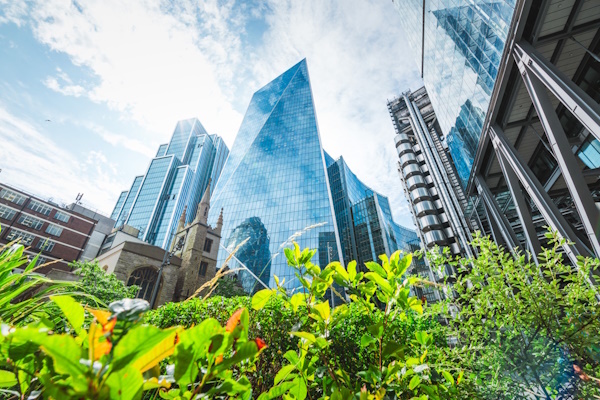Building for net zero
Sponsored by Schneider ElectricBuildings consume 40 per cent of the world’s energy – but one French company’s net-zero energy management for sustainable and efficient buildings is changing the landscape.
Media coverage of the transition to a net-zero economy has tended to focus on a handful of innovations and trends that are reducing global warming – a crisis given greater urgency by the sixth report of the UN’s Intergovernmental Panel on Climate Change in August 2021. Direct air capture plants, for instance, can “scrub” around 9,000 tonnes of CO2 from the air annually, while tree restoration, which 48 countries have committed to via the Bonn Challenge, would sequester billions of tonnes of carbon over the next century if commitments are met.
But in the net-zero conversation, the impact of buildings on the trajectory of global warming rarely gets the attention it deserves. Although this is beginning to change, with campaigners now mobilising around issues as specific as insulation, the historic omission of buildings from climate crisis discourse is puzzling: 40 per cent of the world’s total energy – and within that, 60 per cent of its electricity – is consumed within buildings. Also, the materials used to build them are often harmful to the environment, while areas in which they predominate are hostile to wildlife and flora.
While greater attention to energy usage, installation of double glazing and other strategies can reduce the impact old buildings have on the planet, they will only ever be marginal. The advent of environmentally mindful building design is relatively new: most of the world’s buildings were constructed long before climate consciousness began to move towards mainstream thinking. We will always need buildings for the bulk of human activity – work, home life, entertainment, retail – but it’s clear that their energy usage has to change. And given the irrefutable impact they are having on the warming of the earth’s temperatures, what exactly can be done?
The answer may have been provided by a 185-year-old French industrial multinational whose technologies underpin the smooth operation of an estimated 70 per cent of the world’s buildings. Schneider Electric is a global specialist in energy management and automation, which began life in eastern France as a steel and armaments manufacturer in the 19th century before shifting in the 1970s to electricity.
Today, Schneider Electric is known globally as a leading digital transformation and sustainability partner in the built environment. Using pioneering digital technologies, it has helped create the largest net-zero building in the US, where one-third of all greenhouse gas emissions come from buildings. The 3,000 solar panels on the Unisphere in Maryland, owned by biotechnology company United Therapeutics, produce one megawatt of energy, while an “earth labyrinth” was dug beneath the building for passive cooling and heating. Other features abound: electrochromic glazing on the windows, and an automated natural ventilation system throughout the building.
Similarly, Schneider Electric’s IntenCity building, located in Grenoble, France, has broken new ground in the design of net-zero buildings. Its long, narrow shape allows for sunlight to penetrate every space, thereby reducing the need for artificial lighting, and driving down the release of energy into the atmosphere. It’s a big building, but when its energy-saving system is in full flow, not only does it consume as much as an average family home, but it is also energy positive – like the Unisphere, it generates, stores and releases its own energy. “The best news is that at IntenCity, we consume only what we need,” says Annick Villeneuve, Digital Buildings Solutions of Schneider Electric. “So we have the capacity to stock energy, to consume and produce only the energy that we need in real time, and we can also deliver energy outside the building to others.”
IntenCity uses eight times less energy than the average European building, while packing enough onsite renewable energy generation to power over 200 homes.
There’s a clear sustainability argument for this kind of design, but also a business one: green buildings are, on average, 14 per cent less costly to run than traditional ones, and are worth seven per cent more. Meanwhile, market demand for green buildings doubles every three years. Research also makes clear that demand comes from other areas too: potential employees would choose one job over another on the basis of sustainability, and 70 per cent of millennials cite a company’s sustainability in their decision over whether or not to stay long-term in a job.
There is also, finally, the broader reputational power that adherence to net-zero goals offers. Businesses seen to be going above and beyond to ensure they do their bit for the planet will gain all the advantages any business should desire: of being conscientious, forward-thinking, innovative, an exemplary global player.
As the IPCC report shows, the small adjustments – turning the heating down, keeping the windows closed – just aren’t enough. Radical thinking, and radical action, is needed. Schneider Electric employees talk of “the death of fire” – the switch from fossil fuels and combustion to renewable electricity and greater electrification of buildings as the most realistic way of driving down emissions. With its cutting-edge designs, this “death” is becoming a reality. In a literal and figurative sense, Schneider Electric is building anew.
For more information, please read our new sustainability blog, visit our new sustainability webpage, and read our new e-guide for sustainable buildings.

Business Reporter Team
Most Viewed
23-29 Hendon Lane, London, N3 1RT
23-29 Hendon Lane, London, N3 1RT
020 8349 4363
© 2024, Lyonsdown Limited. Business Reporter® is a registered trademark of Lyonsdown Ltd. VAT registration number: 830519543





